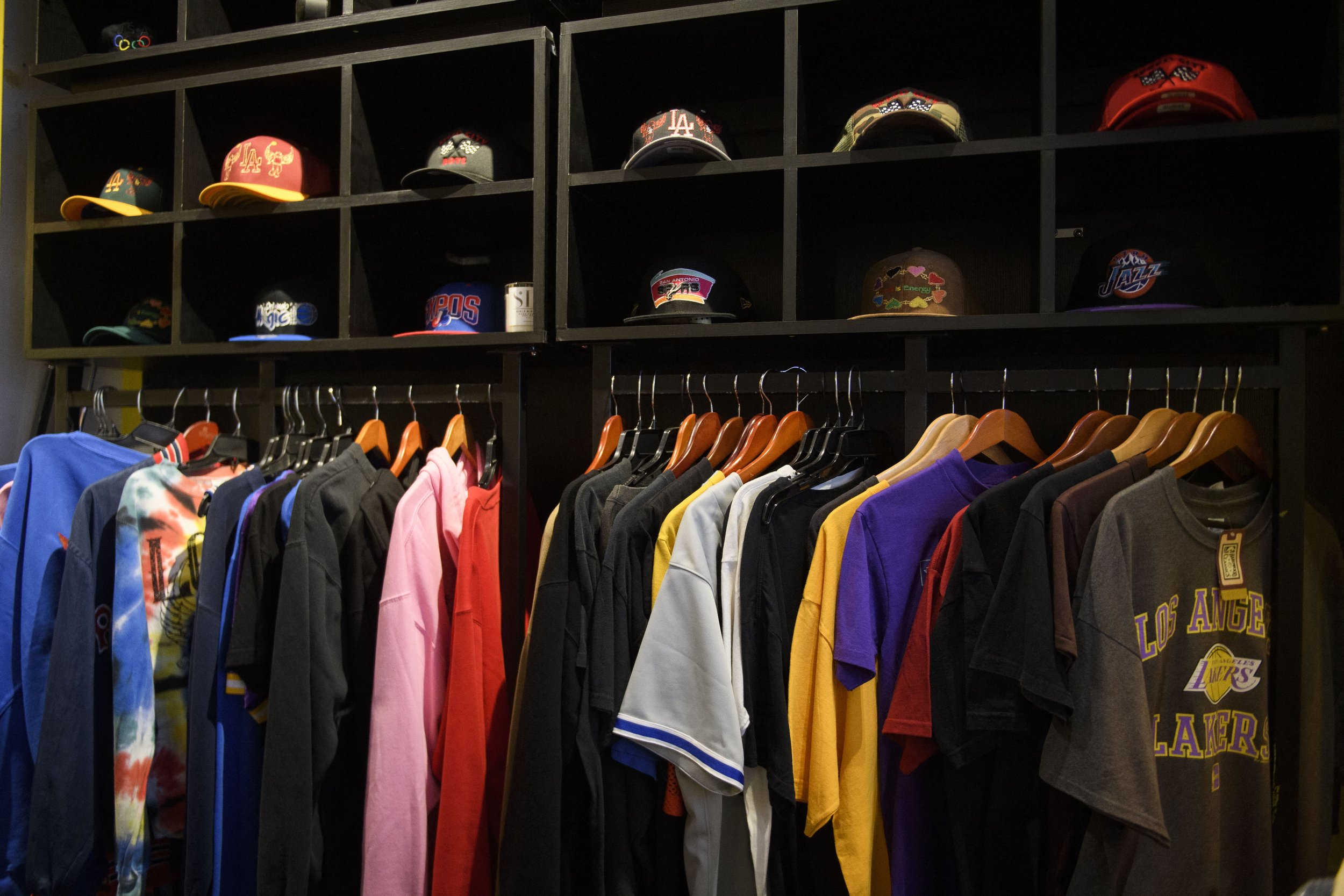We Can’t Shop Our Way Out
Clothing and hats displayed for sale in downtown Los Angeles, California, November 24, 2020. [Patrick T. Fallon/AFP]
Writer Aja Barber loves fashion and hates fast fashion.
Barber’s 2021 book Consumed exposed how the fast fashion industry works, from its cheap and destructive production methods to its tricks for seducing consumers.
I was drawn to the topic after reading an article about Shein, China’s leading fast fashion company, which is now beating runway-to-mall sprinters like Zara and H&M at their own game. Recently, Shein hired a sustainability executive, which to many seemed laughable. When I called Barber and asked what it meant, she laughed and said, “absolutely nothing.”
So what does it mean to love fashion and also love the world? What’s actually sustainable in an era in which every brand seems to be slapping that label on its goods?
Barber and I chatted recently over Zoom.
The interview has been edited for clarity and length.
For context, can you give me a sense of fast fashion’s scale?
The fashion industry produces 150 billion items of clothing a year total as of 2018 – and there are only 7.9 billion humans on the planet. And we also know that a lot of people can’t actually participate in these systems because they live on less than $5.50 a day.
A company like Shein adds 6,000 new items of clothing every day. That's just individual styles. The average cost of an item from Shein is £7.90, which is around $10. They have a 25-day turnaround for a piece of clothing, from conceptualizing it to it being in the warehouse ready to be sold.
How is it possible to produce 6,000 new styles a day?
I think some of it they buy directly from suppliers. If a factory says, we can do this for you, they'll say, great, we’ll take a hundred of those. But I don't really know, to be honest, because they're very mysterious about the inner workings of their business.
People will make a sort of democratic argument for fast fashion – that it’s more affordable, whereas clothing from more ethical brands is often pricier. Are critics of fast fashion elitist?
Well, whenever people bring that up, I say, why don't we talk about higher wages for everyone so that we're all operating with a little bit more money and can make different choices? But no one ever wants to have that conversation.
It almost seems like people are only interested in defending the system so that they can participate in it guilt-free instead of making changes so that no one has to actually buy the sweatshop dress, and so that no one's making the sweatshop dress.
There’s nothing democratic about our privileges coming from the exploitation of others.
And at this scale, we’re probably not talking about things we need anymore.
The average consumer in America buys 68 items of clothing a year. If you can buy 68 items of clothing a year, you might be in a position to spend a little bit more on your clothes. Compared to the average person in 1990, we buy five times more clothing now.
Additionally, at the top of all of these fast fashion pyramids is a billionaire, and it takes money from all classes to build a billionaire. Poor and working-class people only account for 3 percent of America's total wealth. I think there's a lot of middle- and upper-class money that is keeping this system afloat.
I'm not going to show up and slap your credit card out of your hand if you need to buy your work trousers from Shein. I wouldn't judge someone who is in that position. But let's be honest about who's actually in that position and who isn't.
What about the fact that fast fashion brands sometimes have more inclusive sizing than other brands?
I see a lot of thin people using those arguments, but those same people don’t advocate that the brands they buy from include plus-size people. I am someone who is plus size, and I have a rule of thumb that if a brand doesn't dress people who are bigger than me, then I won't buy their clothing.
You write in your book about how colonialism undergirds the fashion industry. How is a Western consumer embedded in those colonial relationships?
Your clothing is produced with resources grown or harvested in the Global South. And it is constructed by workers in the Global South. At the end of its life cycle, when you donate your clothing, because we have such abundance, only about 10 percent of it is going to get resold. The other 90 percent will end up in a landfill or right back in the Global South, where it is received as donations – except that this isn’t really charitable, since at this point it is actually causing environmental damage.
You can see that in places like Ghana and Chile, where the secondhand clothing sent there ends up becoming trash that fills up the local dumps and sits in the desert or on the beaches. People have called this “waste colonialism.”
One of the things that you and others recommend is buying secondhand.
Well, the first thing I tell people is buy less. Everyone needs to buy less.
People always ask me, where do I shop from now? That's the mark of our consumerist society. We have too much clothing – that’s really the crux of the talks that I give. But the question will still be, but where do I shop from now? And it's like, are you not hearing me? People think we’re going to shop our way out of this problem.
The New York Times ran an article recently on all the apps that are coming out to increase transparency around clothes’ supply chains and sustainability. What do you make of those?
I would argue that they're part of the overconsumption problem as well. And who’s watching the watchers? There’s no oversight of what they’re doing, and many of them include affiliate links, so they make money off of you shopping more.
The first thing you should look for is proof that a brand can ensure that every person within their supply chain is paid fair wages. For a lot of the big brands, there's no way that they can do that; they can say they're working towards it, but that doesn't mean that they can ultimately ensure it. [Ed. Note: Big companies use many subcontractors, allowing them to deny responsibility for poverty wages in their supply chains.]
Additionally, paying fair wages is part of solving the climate problem embedded within the fashion industry. If everybody has to pay people fairly, a lot of the overproduction is going to cancel itself out because it won’t be so cheap – there’s a new book about it that’s useful. Fair pay is part of the climate fight.
Style is a form of creative expression and identity, including for people who are marginalized. Is there some way in which identity can be expressed through styles that are not necessarily related to the fashion industry?
When I think about people who wear traditional dress and don’t participate in the fashion industry, they are stylish as hell. I think since I no longer participate in fast fashion, my style has become more elevated because I have to work harder for it. And I'm not chasing every trend. When we're chasing every trend we all just end up looking alike, which is actually quite boring. And so I tell people that fast fashion is killing the innate style that you have because it's forcing you into a box where sometimes you don't fit – and that's quite sad.
If Instagram is full of influencers that do all look quite alike, and do tend to be rich kids, and they bore you, who or what do you follow for inspiration?
Well, living in London is pretty cool because the street style is incredible here. So I'm very privileged in that way. I do follow certain stylish people on apps, but I really enjoy just going out on the street and seeing how people are dressed. I also buy lots of books. And movies, movies, oh my goodness. Films for sure.





